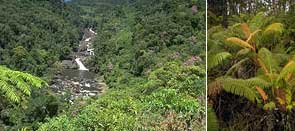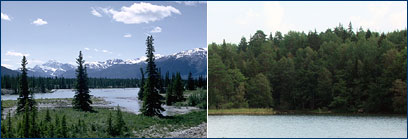The forest biome

A Wisconsin forest.
About 420 million years ago, during the Silurian Period, ancient plants and arthropods began to occupy the land. Over the millions of years that followed, these land colonizers developed and adapted to their new habitat. The first forests were dominated by giant horsetails, club mosses, and ferns that stood up to 40 feet tall.
Life on Earth continued to evolve, and in the late Paleozoic, gymnosperms appeared. By the Triassic Period (245-208 mya), gymnosperms dominated the Earth's forests. In the Cretaceous Period (144-65m mya), the first flowering plants (angiosperms) appeared. They evolved together with insects, birds, and mammals and radiated rapidly, dominating the landscape by the end of the Period. The landscape changed again during the Pleistocene Ice Ages — the surface of the planet that had been dominated by tropical forests for millions of years changed, and temperate forests spread in the Northern Hemisphere.
Today, forests occupy approximately one-third of Earth's land area, account for over two-thirds of the leaf area of land plants, and contain about 70% of carbon present in living things. They have been held in reverence in folklore and worshipped in ancient religions. However, forests are becoming major casualties of civilization as human populations have increased over the past several thousand years, bringing deforestation, pollution, and industrial usage problems to this important biome.
Present-day forest biomes, biological communities that are dominated by trees and other woody vegetation (Spurr and Barnes 1980), can be classified according to numerous characteristics, with seasonality being the most widely used. Distinct forest types also occur within each of these broad groups.
There are three major types of forests, classed according to latitude:
Tropical forest

Left: Ranomafana National Park, Madagascar; right: Hawaiian forest.
Tropical forests are characterized by the greatest diversity of species. They occur near the equator, within the area bounded by latitudes 23.5 degrees N and 23.5 degrees S. One of the major characteristics of tropical forests is their distinct seasonality: winter is absent, and only two seasons are present (rainy and dry). The length of daylight is 12 hours and varies little.
- Temperature is on average 20-25° C and varies little throughout the year: the average temperatures of the three warmest and three coldest months do not differ by more than 5 degrees.
- Precipitation is evenly distributed throughout the year, with annual rainfall exceeding 200 cm.
- Soil is nutrient-poor and acidic. Decomposition is rapid and soils are subject to heavy leaching.
- Canopy in tropical forests is multilayered and continuous, allowing little light penetration.
- Flora is highly diverse: one square kilometer may contain as many as 100 different tree species. Trees are 25-35 m tall, with buttressed trunks and shallow roots, mostly evergreen, with large dark green leaves. Plants such as orchids, bromeliads, vines (lianas), ferns, mosses, and palms are present in tropical forests.
- Fauna include numerous birds, bats, small mammals, and insects.
Further subdivisions of this group are determined by seasonal distribution of rainfall:
- evergreen rainforest: no dry season.
- seasonal rainforest: short dry period in a very wet tropical region (the forest exhibits definite seasonal changes as trees undergo developmental changes simultaneously, but the general character of vegetation remains the same as in evergreen rainforests).
- semievergreen forest: longer dry season (the upper tree story consists of deciduous trees, while the lower story is still evergreen).
- moist/dry deciduous forest (monsoon): the length of the dry season increases further as rainfall decreases (all trees are deciduous).
More than one half of tropical forests have already been destroyed.
Temperate forest
Temperate forests occur in eastern North America, northeastern Asia, and western and central Europe. Well-defined seasons with a distinct winter characterize this forest biome. Moderate climate and a growing season of 140-200 days during 4-6 frost-free months distinguish temperate forests.

From left: Wisconsin woods; a forest along California's north coast; the forested hills of the Adirondacks, New York.
- Temperature varies from -30° C to 30° C.
- Precipitation (75-150 cm) is distributed evenly throughout the year.
- Soil is fertile, enriched with decaying litter.
- Canopy is moderately dense and allows light to penetrate, resulting in well-developed and richly diversified understory vegetation and stratification of animals.
- Flora is characterized by 3-4 tree species per square kilometer. Trees are distinguished by broad leaves that are lost annually and include such species as oak, hickory, beech, hemlock, maple, basswood, cottonwood, elm, willow, and spring-flowering herbs.
- Fauna is represented by squirrels, rabbits, skunks, birds, deer, mountain lion, bobcat, timber wolf, fox, and black bear.
Further subdivisions of this group are determined by seasonal distribution of rainfall:
- moist conifer and evergreen broad-leaved forests: wet winters and dry summers (rainfall is concentrated in the winter months and winters are relatively mild).
- dry conifer forests: dominate higher elevation zones; low precipitation.
- mediterranean forests: precipitation is concentrated in winter, less than 100 cm per year.
- temperate coniferous: mild winters, high annual precipitation (greater than 200 cm).
- temperate broad-leaved rainforests: mild, frost-free winters, high precipitation (more than 150 cm) evenly distributed throughout the year.
Only scattered remnants of original temperate forests remain.
Boreal forest (taiga)

From left: taiga in Jasper National Park, Alberta, Canada; forest west of Stockholm, Sweden.
Boreal forests, or taiga, represent the largest terrestial biome. Occuring between 50 and 60 degrees north latitudes, boreal forests can be found in the broad belt of Eurasia and North America: two-thirds in Siberia with the rest in Scandinavia, Alaska, and Canada. Seasons are divided into short, moist, and moderately warm summers and long, cold, and dry winters. The length of the growing season in boreal forests is 130 days.
- Temperatures are very low.
- Precipitation is primarily in the form of snow, 40-100 cm annually.
- Soil is thin, nutrient-poor, and acidic.
- Canopy permits low light penetration, and as a result, understory is limited.
- Flora consist mostly of cold-tolerant evergreen conifers with needle-like leaves, such as pine, fir, and spruce.
- Fauna include woodpeckers, hawks, moose, bear, weasel, lynx, fox, wolf, deer, hares, chipmunks, shrews, and bats.
Current extensive logging in boreal forests may soon cause their disappearance.
 Freshwater |
 Marine |
 Desert |
 Forest |
 Grassland |
 Tundra |
Top photo by Sherry Ballard © 2004 California Academy of Sciences. Tropical forest photos, from left: Albert P. Bekker © 2000 California Academy of Sciences; Lloyd Gomez © 2004 California Academy of Sciences; Gerald and Buff Corsi © 2000 California Academy of Sciences; Carl Austin Rietz © 2004 California Academy of Sciences. Temperate forest photos, from left: Sherry Ballard © 2004 California Academy of Sciences; Mona Bourell © 1999 California Academy of Sciences; David K. Smith, UCMP. Boreal forest photos, from left: Reuel R. Sutton © 2006 California Academy of Sciences; David K. Smith, UCMP.
--
The original biomes pages were created in fall 1996 by the Biomes Group, Biology 1B class, section 115, at UC Berkeley; all were reformatted, with many new photos added, in March, 2007. Coral reef photo by Marguerite Gregory © 2004 California Academy of Sciences. The pages were re-designed in 2019 as part of a general UCMP website overhaul. Unless noted, content on these pages have not been updated.